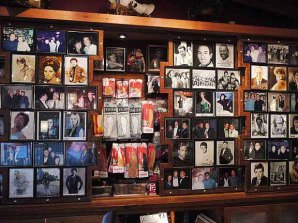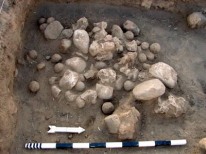The thesis of Hollywood Sapien is that Hollywood has a culture, and all cultures produce artifacts – man-made objects that, when analyzed, tell us something about the culture in which they were produced. In anthropology, we call these studies “material culture” and in fact, for many archaeologists, it’s the only way to learn about the culture of vanished civilizations.*
The entertainment industry produces lots of artifacts: every film, TV show, and YouTube video is itself a cultural artifact, but there are many other artifacts in use in Hollywood that can tell us about its culture. Here we’ll consider one of the most ubiquitous ones: the headshot. While some entertainment industry artifacts (like Avid systems and matte paintings) are relatively few and far between, you find headshots all over the place in Southern California – not just in casting directors’ offices, but on the walls of seemingly every dry cleaner and auto repair shop in L.A.
Headshots have both a totemic function (to people not working in the entertainment industry) and a commercial one (to people who are). The totemic function comes across on that dry cleaner’s wall – along with the car stereo stores, hairdressers, coffee shops, and everyplace else that has rows of headshots hanging, touting their celebrity clients. Like other tribal totems, these headshots are meant to summon some of the power (the fame, image, and cachet) of those celebrities to the shop where they hang. And by frequenting the shops where they appear, people get to bask – just a little – in the reflected glow of stars.

Headshots as totems at a shoe repair shop. If you live in L.A., you probably see walls like this all over the place.
Artifacts are created for many reasons: some for ritual or religious use, some for entertainment, or as tools. One of the most important things to note about headshots as artifacts is that they are objects produced for commercial use. While commercial photography itself is very common, that’s not usually the case for portraits, which even when commercial in origin are mostly intended to have a personal use (like the picture of your friend’s baby taken at the Sears photo studio hanging on your fridge). Headshots, on the other hand, are commercial images, but not personal ones; I’ve never seen one hanging in an actors’ home, in the way that personal snapshots and other photos do.
When I worked on a Roman archaeological site many years ago, one of the things we couldn’t believe is just how many damn pots those Romans made. Similarly, another remarkable thing about headshot artifacts in the sheer number of them in circulation – every actor has two or three at any given time, and gets new shots made roughly every three or four years. Even with the conservative estimate of a little over 21,000 working actors in Hollywood at any given time (see https://hollywoodsapien.wordpress.com/2012/07/05/how-many-actors-are-in-l-a/entry), that means well over 100,000 headshots in existence.
The number involved directly in the casting process are also amazing: one casting director told me that for a minor guest star role on a network TV show, there will be between 1,500-3,000 actors vying for each spot; a typical sitcom episode might have one or two guest stars a week, an hourlong drama three to seven. So for any given hour of television, a casting professional might have to look at 15,000 headshots – EVERY WEEK. Of course, people doing the casting often don’t even see the full headshot; most of the time, they see just a tiny thumbnail, which they scroll past on a computer screen, like these:

Thumbnail page from a casting site. You can see 12 images here, so for a single week’s episode of a network TV show, a casting director might have to look at over 1200 pages just like this one. Yikes.
Which makes you feel bad sometimes for all the skill of the photographers who took the shots, and the actors who anxiously pore over details of the images: the way their hair looks, the tilt of the head, the crinkle of the smile, etc. Small details don’t even come through the vast majority of the time their headshots will be seen by casting directors.*
You can learn a lot about a society from it’s material culture, and we’ve only scratched the surface of what headshots as artifacts can tell us about Hollywood. There are plenty of topic for the next Sapien entry: how headshots reflect social and technological trends, the way they exhibit a something called polysemy (when people view the same object in different ways), and how, like many cultural artifacts, a history that can be traced in how they are made and what they look like. Until then…
— Scott Frank
- Fear not, actors and photographers; obviously the time and energy you put into taking, editing, and selecting headshots isn’t really wasted: casting directors do see the details when they click on thumbnails or receive a copy of an actors physical headshot.
- The impetus for this entry is an academic article I wrote on headshots that just got published in a scholarly journal – for which I interviewed a number of actors, headshot photographers, and casting professionals. If you’re interested in that version, in all it’s dense academic-ese glory, the full citation is “Ready for Your Closeup? Polyvalent Identity and the Hollywood Headshot” in Visual Anthropology Review, volume 28 number 2, pages 180-189 (coming soon to a university library near you).
- To my anthropologist and archeological colleagues – yes, I understand the distinction between how archaeological and material studies work; but for the lay audience, the relationship seems key.
